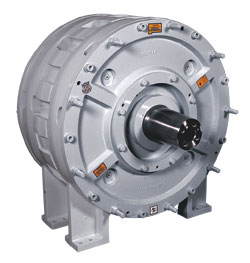|
Vol. 226 No. 12 |
| |
 |
Rig Floor Equipment
Liquid-cooled brakes dissipate very high heat
With rigs capable of drilling to 30,000 ft-plus, drawworks in excess of 4,600 hp, topdrives with 60,000 ft-lb torque and hook loads in excess of 1.3 million lb, drillers need the most rugged clutches and brakes available. And that’s just topsides.
 |
KopperKool’s patent-pending, pressure-balanced, waterflow design maintains a uniform temperature across the surface of the wearplate.
|
|
Downhole, high temperature and high pressure become even more important in the design of a rig’s drawworks. For drawworks applications, Wichita Clutch’s proprietary Kopper Kool clutches and brakes are designed for very high heat dissipation in the most rugged tensioning applications. Tangential cooling grooves ensure effective mixing of cooling water for best heat conductivity. Water volume of the jackets ensures high-water velocity, which reduces sedimentation and chemical formation.
Maximum inlet pressure is 60 psi. All coolant and air connections are external and easily accessible. Double outlets are situated in the center waterjackets for multiple plate units 24 in. and larger. Air passages through the brake greatly assist in keeping the brake cool.
Torque levels are in direct proportion to air pressure, providing accurately controlled, continuous slip-braking action. The copper-alloy wearplates increase heat transfer, which allows for high acceleration and deceleration speeds. The use of copper has a greater heat transfer capacity than any other metal, other than precious metals.
The new patent-pending, pressure-balanced, waterflow design maintains a uniform temperature across the surface of the wearplate. The balanced flow across the plate allows for a 50% higher temperature rise per plate than the competition, and from 15% to 54% higher pressure dissipation, depending on the application. The balanced flow also prevents hotspots from forming that can lead to percolating and pressure spikes in the water system.
Each liquid-cooled brake consists of a series of alternating discs connecting an inner drive member to an outer drive member. Brake engagement is achieved by pneumatic expansion of the air tube. The new friction material lasts longer, with less wear on the mating copper. This results in longer performance time and lower replacement costs. The hub spline provides rotating disc alignment for better engagement and disengagement of the brake. Release springs ensure complete disengagement.
Generated teeth, in addition to aligning rotating members, offer maximum torque to pressure sensitivity. All factors affecting torque are fully controlled. 
|




